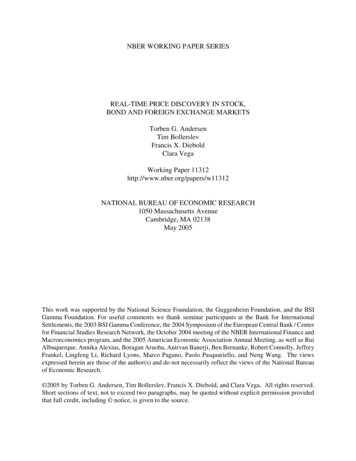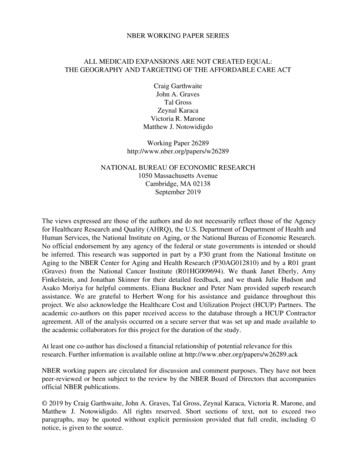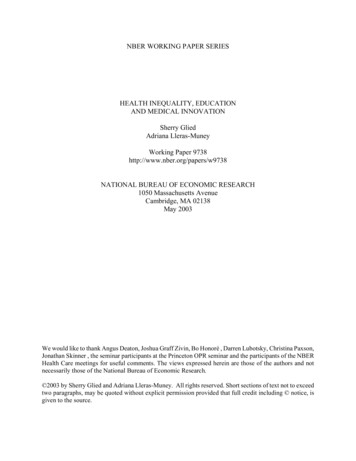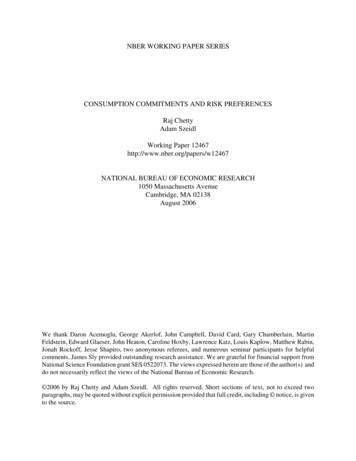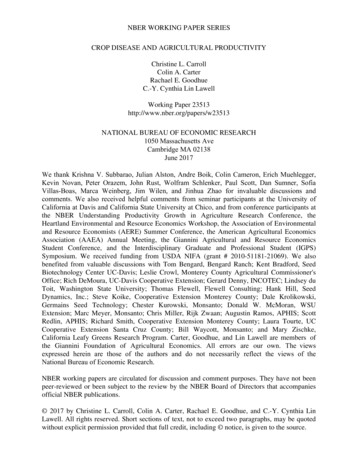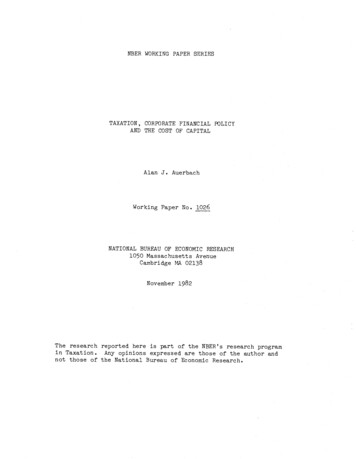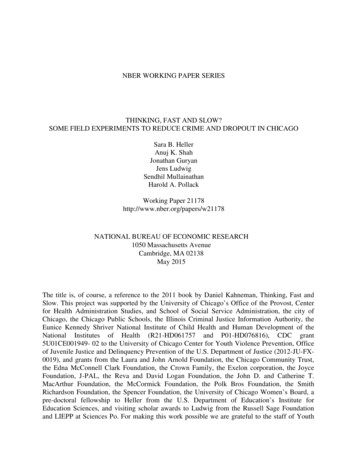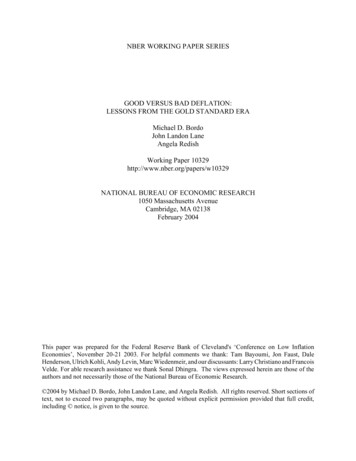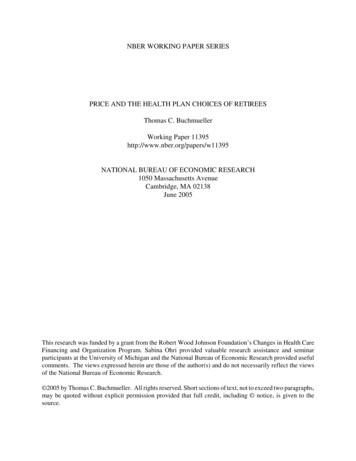
Transcription
NBER WORKING PAPER SERIESPRICE AND THE HEALTH PLAN CHOICES OF RETIREESThomas C. BuchmuellerWorking Paper 11395http://www.nber.org/papers/w11395NATIONAL BUREAU OF ECONOMIC RESEARCH1050 Massachusetts AvenueCambridge, MA 02138June 2005This research was funded by a grant from the Robert Wood Johnson Foundation’s Changes in Health CareFinancing and Organization Program. Sabina Ohri provided valuable research assistance and seminarparticipants at the University of Michigan and the National Bureau of Economic Research provided usefulcomments. The views expressed herein are those of the author(s) and do not necessarily reflect the viewsof the National Bureau of Economic Research. 2005 by Thomas C. Buchmueller. All rights reserved. Short sections of text, not to exceed two paragraphs,may be quoted without explicit permission provided that full credit, including notice, is given to thesource.
Price and the Health Plan Choices of RetireesThomas C. BuchmuellerNBER Working Paper No. 11395June 2005JEL No. I11, D12ABSTRACTThis study analyzes health plan choices of retirees in an employer-sponsored health benefits programthat resembles "premium support" models proposed for Medicare. In this program, out-of-pocketpremiums depend on when an individual retired and his or her years of service as of that date. Sincethis price variation is exogenous to unobserved plan attributes and retiree characteristics, it possibleto obtain unbiased premium elasticity estimates. The results indicate a significantly negative effectof premiums. The implied elasticities are at the low end of the range found in previous studies onactive employees.Thomas C. BuchmuellerPaul Merage School of BusinessUniversity California, IrvineIrvine, CA 92697-3125and NBERtcbuchmu@uci.edu
11IntroductionIn recent years, a number of proposals have been made to reorganize Medicare by placing agreater emphasis on market-based competition among health insurance plans.1 In contrastto the current system of administrative pricing, payments to health plans in these “managedcompetition” or “premium support” models would be based on competitive bidding. Thegovernment’s contribution toward coverage would be set so as to expose beneficiaries todifferences in premiums charged by competing plans. Individuals choosing a more costly planwould be required to pay the difference between the plan’s premium and the governmentcontribution. Advocates of market-oriented reform argue that these financial incentives willcause beneficiaries to migrate to lower cost plans, which, in turn, will create a strong incentivefor plans to control costs in order to compete on price.To assess the potential impact of market-oriented reform proposals, it is necessary tounderstand the price sensitivity of Medicare beneficiaries. While a number of studies examinethe effect of premiums on the choice among alternative health plans, this literature has largelyfocused on the behavior of non-elderly employees. An obvious concern is that the resultsfrom these studies may not generalize to the Medicare population. In particular, there areseveral reasons to suspect that older consumers may be more reluctant to switch healthinsurers and less sensitive to price than younger workers.This study investigates the effect of premiums on the health insurance decisions of retireesin a setting that resembles prominent Medicare reform proposals. The analysis is based on sixyears of data from a large employer that offers its retirees several health insurance options.Like many employers, in the mid-1990s this company changed its policies concerning thefinancing of these insurance options. Whereas it had previously paid the full amount for eachretiree’s insurance, the amount the firm now contributes toward a retiree’s coverage depends1The most prominent examples are proposals that came out of the National Bipartisan Commission on TheFuture of Medicare. In 1999, the majority of the Commission’s members supported a market-oriented reformproposal, though this proposal did not achieve the super-majority necessary for a formal recommendation.Subsequent legislative proposals include bills authored by the chairmen of the Commission, Senator JohnBreaux and Congressman Bill Thomas and more recent legislation proposed by Breaux and Senator BillFrist (S. 357). These bills have important similarities to reform strategies advocated by academic healtheconomists and other policy analysts. For example, see Enthoven (1988), Aaron and Reischauer (1995),Butler and Moffit (1995) and Dowd, Feldman and Christianson (1996).
2on when the person retired and her years of service at that point. Because otherwise similarretirees who either retired at different times or at the same time with different years of serviceface very different relative prices for the same menu of health plans, this policy creates anideal natural experiment for estimating the effect of price on health plan choices. Changesover time in the employer contribution and plan premiums create additional price variationthat is also plausibly exogenous to other health plan attributes and retiree characteristicsthat are likely to affect the demand for insurance.Using these data, I estimate conditional logit models of the health plan choice decision.I find a negative and statistically significant effect of price on the probability a health planis chosen by retirees. The results are robust to alternative assumptions concerning thedefinition of the choice set and to changes in the composition of the estimation sample.The next section reviews the existing literature on the effect of price on health planchoice decisions. Sections 3 and 4 describe the data and econometric methods, respectively.Regression results are presented in the fifth section. The sixth section concludes.2Previous Research on Health Plan ChoiceA number of studies examine the effect of out-of-pocket premiums on health plan choice decisions, typically using data from a single employer and focusing on the decisions of employeesrather than retirees. A key methodological issue for this literature is the source of variationin out-of-pocket premiums. When the variation comes entirely from differences across plans,correlation between premiums and other unmeasured plan characteristics becomes a possiblesource of bias. Barringer and Mitchell (1994) suggest that this type of omitted variable biasis a likely explanation for their counterintuitive finding of a positive effect of price in somemodels. Similarly, in their cross-sectional analysis of data from the Federal Employee HealthBenefit Program, Wedig and Tai-Seale (2002) find that the estimated effect of premiums isvery sensitive to the inclusion of other plan characteristics in the regression model.The most convincing evidence on premium elasticities comes from studies that rely onwithin-plan differences in employer premium contributions for identification. Feldman et al.(1989) use data from 17 Twin Cities firms that offer an overlapping set of health plans to
3their employees. In this data set differences in employer contribution policies mean thatdifferent individuals face different prices for the same plans. Three other studies analyzethe effect of price differences generated by changes in a single employer’s contributions fromone year to the next. Cutler and Reber (1998) examine the effects of a change in HarvardUniversity’s health plan contribution policy that changed out-of-pocket premiums for employees over a two year period. The employee response to the price change in the first yearimplies an “enrollee perspective” premium elasticity of -0.3. The response in the second yearimplies an elasticity of -0.6. Royalty and Solomon (1999) analyze two years of data fromStanford University. Their conditional logit results imply enrollee perspective elasticitiesin the same range; results using a fixed effect logit specification imply even stronger priceeffects. Strombom et al. (2002) estimate premium elasticities using data on employees ofthe University of California (UC). The range of their elasticity estimates is similar to thoseof the two earlier studies.There are reasons to expect Medicare beneficiaries to be less sensitive to health insurancepremiums than the active employees analyzed in these studies. Research on how the elderlyperceive health insurance options suggests they place much more importance on factors suchas quality of care, freedom of referral, and the burden of paperwork than on premiums (Harris1997; Harris and Keane 1999). Thus, to the extent that Medicare beneficiaries view planalternatives as being differentiated along these other dimensions, their choices will be lessstrongly influenced by differences in premiums. Experimental research finding that elderlyconsumers are more likely to treat health insurance premiums as a signal of quality (Uhrigand Short 2002/2003) also points to a negative relationship between age and price sensitivity.An additional reason to expect older consumers to have a less elastic demand for healthinsurance comes from the fact that health insurance decisions are subject to persistence and“status quo bias” (Neipp and Zeckhauser 1985; Samuelson and Zeckhauser 1988). To theextent that older consumers face higher “switching costs,” they will be less willing thanyounger individuals to change plans in response to a change in relative prices. In particular,Medicare beneficiaries with strong ties to certain providers may be reluctant to switch fromone managed care plan to another if it means also having to change providers or to risk aninterruption in treatment.
4The results of several studies suggest the importance of switching costs in health insurancedecisions. Strombom et al. (2002) estimate separate premium elasticities for 18 mutuallyexclusive groups of employees hypothesized to differ in terms of the cost of switching healthplans. Consistent with the switching cost hypothesis, they find that price sensitivity declineswith age and employment tenure and is lower for individuals with higher expected medicalcare utilization. Royalty and Solomon (1999) obtain qualitatively similar results when theytest for differences in price sensitivity related to age, employment tenure and a differentmeasure of health status. Wedig and Tai-Seale (2002) also find that new employees aresubstantially more price sensitive to incumbent employees, and Beaulieu (2002) finds someevidence that younger employees are more price sensitive than older ones.While limited, direct evidence on the behavior of elderly consumers also suggests thatthey are less sensitive to health plan premiums than younger consumers. In an earlierstudy, I examine how retirees from the UC responded to changes in out-of-pocket premiumscaused by a change in the University’s premium contribution (Buchmueller 2000). Theresults indicate that while changes in out-of-pocket premiums have a statistically significanteffect on the decision to switch plans during open enrollment, UC retirees are less pricesensitive than active employees who faced similar price changes. I also examine the effect ofrising premium contributions on the percentage of retirees choosing fee-for-service Medigapcoverage rather than an HMO. The structure of this part of the analysis resembles the workby Cutler and Reber (1998). The enrollee perspective elasticities for UC retirees range from-0.12 to -0.24, which is smaller than the range of Cutler and Reber’s (1998) estimates.Atherly, Dowd and Feldman (2004) use data from the 1998 Medicare Current BeneficiarySurvey (MCBS) to estimate premium elasticities for beneficiaries living in areas where morethan one HMO was available through the Medicare Choice program. Since they excludefrom their analysis individuals with retiree health benefits through a former employer, theirsample represents a different subset of the Medicare population than the UC retirees. Dowd,Feldman and Coulam (2003) conduct a similar analysis using aggregate (county-level) datafrom 1999. The results from these two studies are quite similar to the results for UC retirees,with estimated premium elasticities of -0.14 (Atherly, Dowd and Feldman) and -0.13 (Dowd,Feldman and Coulam).
5Each of these studies on the plan choices of Medicare beneficiaries has significant methodological limitations. Because in the UC data there was little price variation among HMOs,the choice that is modeled is the decision to join the single PPO option or to enroll in oneof several HMOs. Consequently, the results may not apply well to the situation envisionedby Medicare reform proponents, where there is price competition among multiple managedcare plans. This problem may be exacerbated by the fact that over half of UC retirees werealready in HMOs before there was a price differences between the HMOs and the PPO option. It may be that many of the PPO enrollees who faced the price increase had a strongaversion to more tightly managed care and were therefore willing to pay substantially higherprices rather than switch to an HMO. As a result, the UC results may understate the averagedemand elasticity for the Medicare population.Since the other two studies on Medicare beneficiaries are based on national data, it wouldseem that they are not subject to the same concerns about generalizability as ones usingdata from a single firm. However, because of numerous exclusions, the samples used arenot representative of the entire Medicare population either. In addition, there are otherpotentially important methodological problems with each study. The most significant one isthat because both use cross-sectional data all the variation in prices is across plans. Sinceit is not possible to fully control for plan benefits and other important plan characteristicsthat may be correlated with price, omitted variable bias is a concern.2This problem may be exacerbated by substantial ambiguity about the actual plan choiceof beneficiaries. It is common for HMOs that participate in Medicare to offer multiple plansthat differ in terms of both the extent of coverage and the premiums charged to beneficiaries.Nearly 40% of HMO members in the MCBS data used by Atherly, Dowd and Feldman areenrolled in HMOs offering multiple options. It is not possible in either the MCBS or theaggregate data used by Dowd, Feldman and Coulam to distinguish enrollment in a lessgenerous, lower cost option from enrollment in the more comprehensive and more costlyplan offered by the same HMO. In these cases, both studies assign enrollment to the HMOs2The expected direction of this bias is unclear. If more expensive plans offer richer benefits or contractwith more highly regarded providers, the correlation between price and plan quality will cause the effect ofprice to be biased toward zero. However, rules governing HMOs in Medicare may lead to a bias in the otherdirection. During the period analyzed in these studies, plans in areas with high capitated payment ratestended to offer additional benefits, such as richer drug coverage, and charged zero premiums.
6lower cost plan. It is not clear how this imputation affects the estimated price effects.3These methodological problems do not arise arise in the data I use in this study. Becauseof the way the employer’s premium contributions are set, there is substantial within planvariation in out-of-pocket premiums. In addition, since I use administrative enrollment dataI know exactly what plans an individual was offered, the out-of-pocket premiums for eachplan and which option was chosen. I turn now to the details of these data.3Data3.1The SampleThis analysis is based on administrative health plan data from an employer with roughly2,700 employees located in the Southwestern United States. The data are for the years 1997to 2002, during which time the number of retirees eligible for health benefits grew from 924to 1,244. Many of these are individuals who retired before age 65. There are arguments forand against including these early retirees in the analysis. Since plan benefits do not changewhen a retiree becomes covered by Medicare, but the required premium contributions do,pooling retirees above and below age 65 provides additional price variation. Including preMedicare retirees also allows for larger sample sizes. On the other hand, to the extent thatyounger retirees behave differently than older ones, the results may not generalize well tothe Medicare population. To mitigate these concerns, I exclude retirees under age 60 fromthe analysis. To further reduce heterogeneity within the sample, I also exclude individualswho retired before January 1986. These inclusion criteria result in a maximum sample sizeof 3,230 observations on 724 retirees.3.2The Choice SetIn each year from 1997 to 2002, retirees and active employees had four health insuranceoptions to choose from: three health plans and a cash payment for declining coverage. Two3In the study by Atherly, Dowd and Feldman, there is an additional measurement problem. While oneof the options they model is Medigap coverage, they lack good data on the Medigap premiums faced byindividuals in their sample.
7of the health plans are HMOs, which I will refer to as HMO A and HMO B in order tomaintain the anonymity of the employer providing the data.4 The other plan on the menuis a PPO. For enrollees living in its service area, the PPO has a 250 per-person deductible,a 10% coinsurance rate for providers in the plan’s network, and a 50% coinsurance rate fornon-network providers. For retirees outside the service area who use non-network providers,the coinsurance rate is 20%.While all employees and retirees have the option of declining coverage, the exact menuof health plans depends on where an individual lives.5 Approximately two-thirds of retireesface the full choice set, 7% face the choice of one HMO and a PPO option, and roughlyone-quarter choose between the PPO and the cash payment for declining coverage.3.3The Price VariableWhat makes these data well suited for analyzing the effect of price on the choice of healthplans is that there is substantial variation in premium contributions facing retirees sharinga common choice set. Essentially, the data set combines the type of cross-sectional pricevariation exploited by Feldman et al. (1989) with the intertemporal variation that is the basisfor the estimates by Cutler and Reber (1998), Royalty and Solomon (1999) and Strombomet al. (2002).The cross-sectional variation comes from the way that the employer’s contribution depends on a retiree’s prior work history. The rules for determining the employer contributiondiffer across three groups of retirees: (1) those retiring on or before January 1, 1988; (2)those retiring between January 2, 1988 and January 1, 1993; and (3) those retiring afterJanuary 1, 1993. For the first group, the employer contribution covers the full cost of allplans. For individuals retiring between 1988 and 1993, the employer contribution depends oncoverage tier (i.e., single, two-party) and is set below the premium of the PPO, which is themost costly plan. As a result, premiums vary by plan, coverage tier and Medicare status. All4Both plans are headquartered in the same city as the employer, have long histories there and are similarin other important respects. For example, they receive comparable scores on various quality “report card”measures. In 2001, 14% of all Medicare beneficiaries in the county where the employer and the two plansare located were enrolled in Plan A, and 12.4 % were enrolled in Plan B.5Because the data I use comes from the same system that generates Open Enrollment materials sent toemployees and retirees, there is no ambiguity as to which plans are available to each individual.
8pre-1993 retirees who decline insurance coverage receive 75 per month. For individuals whoretired after January 1, 1993 the employer’s contribution decreases by a fixed percentage foreach year of service less than 25.6 Thus, for this group, out-of-pocket premiums vary withinas well as across plans.To give a sense of how the rules of the program lead to differences in relative prices, Table1 presents the 2002 retiree premium contributions for different retiree profiles. The data inthe top panel show that all plans are free for individuals who retired before January 1988. Asa result, these retirees represent a “control group” when considering the effect of premiumson health plan decisions. For individuals retiring between 1988 and 1993 (second panel),out-of-pocket prices depend on coverage tier and Medicare status. In 2002, the differencebetween the cost of the PPO and HMO B ranged from 27.24 ( 65.49 - 38.25) for single,pre-Medicare coverage to 144.81 for two-party Medicare coverage; the mean difference was 70 per month.7 For Medicare beneficiaries in this cohort the 2002 prices for the two HMOsare identical, while for pre-Medicare retirees Plan A requires a slightly larger contribution.8The last two panels of Table 1 summarize the situation of post-1993 retirees with 20 and10 years of service. For a single Medicare-eligible retiree with 20 years of service, the monthlycost for the PPO is 82.54 more than the cost of the less expensive HMO. This amount islarger than the difference facing an otherwise identical individual who retired between 1988and 1993 ( 50.24), but smaller than the difference for someone who retired at the sametime with only 10 years of experience ( 147.13). For all post-1993 retirees HMO A is moreexpensive than HMO B; this price difference is larger for retirees with fewer years of service.One potential concern regarding the variation induced by the company’s premium contribution policy is that it may have affected the timing of some employees’ retirement decisions.6Post-1993 retirees with 25 or more years of service receive the same contribution, and therefore face thesame prices, as retirees in the middle cohort. For post-1993 retirees with less than 25 years of service, theout-of-pocket premium for plan j is Pj Fj - C(1 - .04(25 - s)), where Fj is the plan’s full premium (i.e.,what the health insurer charges the employer), C is the amount the employer contributes for the middlegroup of retirees and s is the individual’s years of service at the time of retirement.7This mean is calculated using the premium contributions corresponding to each individual’s chosencoverage tier.8Differences in the way the PPO and the two HMOs are underwritten lead to differences in the relationshipbetween premiums and coverage tier. For example, note that for the 1988-1993 retirement cohort there is nodifference in the PPO premium charged for a husband and wife who are both under age 65 and a husbandand wife where one person is on Medicare and the other is not. In contrast, these two types of couples facedifferent HMO premiums.
9If such effects were large, it would raise questions about the exogeneity of the price variable.As it turns out, this is not an issue, since the change in the health insurance contributionpolicy was enacted retroactively. An examination of the timing of retirements since 1985suggests that, if anything, the company chose the retirement date cut-offs to fall just beforespikes in retirement in the fourth quarter of 1988 and the second quarter of 1993 (data notshown).Additional variation comes from changes in the level of the employee contribution andchange in total premiums for the plans.9 For pre-1988 retirees premium contributions areconstant at zero throughout the time period analyzed, whereas relative prices have changedover time for the other two cohorts. For most individuals in most years, the PPO option ismore expensive than the HMOs. The average difference between the contribution requiredfor the PPO and the price of the lowest cost HMO option declined from 1997 to 1999 andhas increased thereafter. Premiums have evolved differently for the two HMOs. In someyears they have the same price for all retirees, while in other years, like 2002, this is true forsome retirees but not others.3.4CovariatesThe administrative data includes information on age, gender, marital status10 and whetheror not the covered individual is a surviving spouse of a former employee of the company.As with most studies in this literature, other correlates of medical care utilization are notavailable. As a result, it is not possible to test for differences in price-sensitivity related toexpected health care costs or to conduct other tests related to the problem of adverse riskselection. However, the lack of health information does not pose problems for estimatingaverage elasticities for all retirees. Retiree income is also unobserved. As a proxy, I usedata from the 2000 Census on the ZIP-code level median income for households with headsbetween the ages of 65 and 74. The data on ZIP code is also used to create an indicatorvariable for retirees living outside of metropolitan areas. This variable enters the regression9In the regression analysis, prices are normalized to 2002 dollars using the Consumer Price Index.Unlike data used in most prior studies, this is actual marital status, not simply whether or not the retireehas chosen to cover a dependent spouse.10
10models to account for the fact that HMO coverage will tend to be less attractive to individualsliving in rural areas.Table 2 summarizes the observed characteristics of the retirees in the sample, stratifiedby retirement date. The figures illustrate why I exclude individuals who retired before 1986.They are substantially older and different in other ways from the more recent retirementcohorts. Since pre-1988 retirees face very different prices than the later two cohorts, includingthese older retirees would raise a concern that the estimated effect of price would be biasedby unobserved heterogeneity. Individuals who retired between 1986 and 1988 are also olderthan more recent retirees, though the difference is not large: their mean age is 69.7 yearscompared to 68.2 for individuals retiring between 1988 and 1993. They are also similar tothe latter two cohorts in terms of the percent who are married and the percent who are male.Individuals who retired between 1986 and 1988 are less likely to live in metropolitan areasthan members of the two later cohorts. Differences among the three cohorts in the ZIP codelevel income variable are not significant.3.5The Distribution of Plan EnrollmentTo give a preliminary sense of how price affects the health plan choices of these retirees,Table 3 reports the distribution of plan enrollment for 2002 broken down by retirementcohort. Overall, the PPO is the most popular plan, enrolling almost half of the retirees inthe sample. HMO B has a higher enrollment share than HMO A (32% vs. 13%); 9% ofthe sample decline coverage. Differences across retiree cohorts suggests that price is a factoraffecting health plan choice decisions. PPO enrollment is greatest for pre-1988 retirees, forwhom such coverage is “free” and is lowest for post-1993 retirees, who face the highestprices for the PPO option. The inverse pattern is observed for the percentage of retireeschoosing HMO coverage. As would be expected, waiving is least common for pre-1988retirees, though there is no significant difference across the other two cohorts in the percentwaiving coverage.1111This latter result is partly explained by the fact that a larger share of the post-1993 retirees are underage 65. As will be shown below, retirees who are not yet eligible for Medicare are less likely to waive coverage.
114Econometric SpecificationI estimate premium elasticities based on a conditional logit regression model12 in which theexpected utility that individual i receives from plan j is assumed to be a linear function ofplan attributes and individual characteristics:Vij βPij Zij γ Xi θj uij .(1)The variable of primary interest is Pij , the price that individual i must pay for option j.The vector Z represents other plan attributes. Since in these data the non-price attributes ofeach plan (e.g., benefits, provider panels, quality reputation) are the same for all individuals,Z consists of a set of plan dummies13 plus a dummy variable that equals one for two-partycoverage and zero for single coverage.The vector Xi includes individual characteristics that are assumed to be related to preferences for the different alternatives. Age enters as a continuous variable along with anindicator variable that equals one for individuals who are under age 65 to account for thefact that a person’s outside options change discretely when she qualifies for Medicare. Sincea key source of price variation is across retirement cohorts, it is important to be sure thatthe results are not sensitive to the treatment of age. For this reason, I also estimated modelswhere age was parameterized as a quadratic and with a set of categorical variables. Sincethe estimated price elasticities are not at all sensitive to the way age enters the model, Ireport the results from this more parsimonious and easily interpreted specification. Theother control variables are the ZIP code level median income variable and indicator variablesfor marital status, coverage as a surviving spouse of a former employee, and residence in a12A well known limitation of this model is that it is subject to the independence of irrelevant alternatives(IIA) condition, which implies strong restrictions on the predicted substitution patterns. An alternativemodel that is not subject to IIA is the “mixed logit” model (McFadden and Train 2000; Train 2003), whichallows utilities to be correlated across alternatives. I estimated several versions of mixed logit models incorporating different distributional assumptions. While these alternative models performed slightly better thanthe standard conditional logit model in terms of log-likelihood the models did not differ in any meaningfulway in terms of the implied elasticities.13Chernew et al (20
perceive health insurance options suggests they place much more importance on factors such as quality of care, freedom of referral, and the burden of paperwork than on premiums (Harris . effect on the decision to switch plans during open enrollment, UC retirees are less price sensitive than active employees who faced similar price changes. I .
